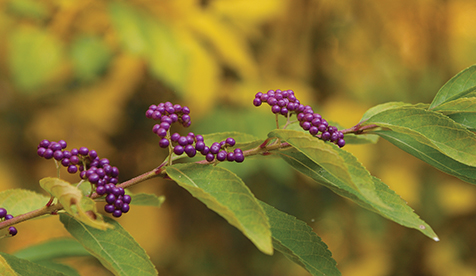Reds, yellows, oranges — these are the bright colors of the coming autumn in the garden. And so is purple.
Yes, purple, which is brazenly flaunted in the fall by a botanical floozy known as beautyberry (Callicarpa sp.). Spending the warmer months slumbering in a sea of green, this bush celebrates summer’s exit in a pleasantly gaudy display of arching stems loaded with berry clusters that turn ultra-violet and scream, “Look at me!”
The beautyberry has long been a favorite of gardeners in the know who want to bring extra zing to fall landscapes. Easily found in nurseries at this time of year, this deciduous shrub typically grows up to 6 feet tall, but can stretch to 10 feet in height. It does best in well-drained soil and in a location that receives some light shade, particularly in the afternoon.
Small pale pink or white flowers are produced on new wood in the spring (meaning that the best time to prune this shrub is late in the winter), and they are followed by clusters of green berries that slowly slip into their show-stopping purple with the approach of autumn. These berry nice displays are highlighted even more when the fall foliage provides a backdrop of pleasing yellow.
The American beautyberry (Callicarpa americana) is as advertised, a plant native to our country, and it is commonly found in the woodlands of the Southeast. Being well-adapted to the Southern wilds means it is also a low-maintenance shrub for typical landscapes in our area. In addition, it is a rabbit- and deer-resistant ornamental. The drupes of berries normally seen on this bush form tight bands that take on the fun look of sassy purple bracelets.
 The berry clusters of the Japanese beautyberry (Callicarpa japonica) are more dispersed along its branches, but still very pretty. This Oriental import reaches about the same size as its American cousin and shares the same resistance to munching wildlife. It can also make a similar statement in the landscape as a single specimen planting or grouped to form a handsome autumn hedge.
The berry clusters of the Japanese beautyberry (Callicarpa japonica) are more dispersed along its branches, but still very pretty. This Oriental import reaches about the same size as its American cousin and shares the same resistance to munching wildlife. It can also make a similar statement in the landscape as a single specimen planting or grouped to form a handsome autumn hedge.
Have limited space in your garden? Have a look at Callicarpa dichotoma. Another beautyberry from the Far East, it usually tops out at a mere 4 feet tall and about as wide. Although smaller in stature, its eye appeal is still apparent with its royal purple berries that appear in the fall. ‘Early Amethyst’ and ‘Issai’ are popular cultivars of this species.
If shocking purple is an overload on your senses, there are kinder, gentler cultivars that modestly display white berries. The American beautyberry has the ghostly ‘Lactea’ and ‘Russell Montgomery’ selections, while ‘Leucocarpa’ shows off the Japanese beautyberry’s lighter side. And berries in a whiter shade of pale can also be had with ‘Albifructus’, a cultivar of Callicarpa dichotoma.
To many, the beautyberry’s eye-catching fruits are Garden-of-Eden-like tempting — so, are they edible? Well, it depends on your definition of “edible.” Although wines and jellies have been made from the berries, right off the branch, their taste ranges from bland to astringent, bordering on unpleasant. Birds will eat them, but these long-lasting berries don’t seem to be their most favorite of fall and winter food.
For gardeners, in autumn, the beautyberry is perhaps best enjoyed with the eyes, and, boy, what a sight it is to see!
L.A. Jackson is the former editor of Carolina Gardener magazine.Pretty in Purple







